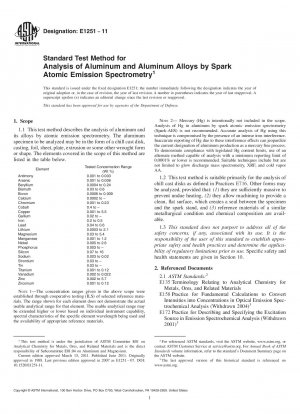ASTM E1251-11
Standard Test Method for Analysis of Aluminum and Aluminum Alloys by Spark Atomic Emission Spectrometry
- Standard No.
- ASTM E1251-11
- Release Date
- 2011
- Published By
- American Society for Testing and Materials (ASTM)
- Status
- Replace By
- ASTM E1251-17
- Latest
- ASTM E1251-17a
- Scope
The metallurgical properties of aluminum and its alloys are highly dependent on chemical composition. Precise and accurate analyses are essential to obtaining desired properties, meeting customer specifications and helping to reduce scrap due to off-grade material.
This test method is applicable to chill cast specimens as defined in Practice E716 and can also be applied to other types of samples provided that suitable reference materials are available. Also, other sample forms can be melted-down and cast into a disk, using an appropriate mold, as described in Practice E716. However, it should be noted that some elements (for example, magnesium) readily form oxides, while some others (for example, sodium, lithium, calcium, and strontium) are volatile, and may be lost to varying degrees during the melting process.
1.1 This test method describes the analysis of aluminum and its alloys by atomic emission spectrometry. The aluminum specimen to be analyzed may be in the form of a chill cast disk, casting, foil, sheet, plate, extrusion or some other wrought form or shape. The elements covered in the scope of this method are listed in the table below.
ASTM E1251-11 Referenced Document
- ASTM E1329 Standard Practice for Verification and Use of Control Charts in Spectrochemical Analysis
- ASTM E135 Standard Terminology Relating to Analytical Chemistry for Metals, Ores, and Related Materials
- ASTM E1507 Standard Guide for Describing and Specifying the Spectrometer of an Optical Emission Direct-Reading Instrument
- ASTM E158 Standard Practice for Fundamental Calculations to Convert Intensities into Concentrations in Optical Emission Spectrochemical Analysis (Withdrawn 2004)
- ASTM E172 Practice for Describing and Specifying the Excitation Source in Emission Spectrochemical Analysis (Withdrawn 2001)
- ASTM E305 Standard Practice for Establishing and Controlling Spectrochemical Analytical Curves
- ASTM E406 Standard Practice for Using Controlled Atmospheres in Spectrochemical Analysis
- ASTM E691 Standard Practice for Conducting an Interlaboratory Study to Determine the Precision of a Test Method
- ASTM E716 Standard Practices for Sampling Aluminum and Aluminum Alloys for Spectrochemical Analysis
- ASTM E826 Standard Practice for Testing Homogeneity of Materials for Development of Reference Materials
- ASTM E876 Standard Practice for Use of Statistics in the Evaluation of Spectrometric Data (Withdrawn 2003)
ASTM E1251-11 history
- 2017 ASTM E1251-17a Test Method for Analysis of Aluminum and Aluminum Alloys by Atomic Emission Spectrometry
- 2017 ASTM E1251-17 Standard Test Method for Analysis of Aluminum and Aluminum Alloys by Spark Atomic Emission Spectrometry
- 2011 ASTM E1251-11 Standard Test Method for Analysis of Aluminum and Aluminum Alloys by Spark Atomic Emission Spectrometry
- 2007 ASTM E1251-07 Standard Test Method for Analysis of Aluminum and Aluminum Alloys by Atomic Emission Spectrometry
- 2004 ASTM E1251-04 Test Method for Analysis of Aluminum and Aluminum Alloys by Atomic Emission Spectrometry
- 1994 ASTM E1251-94(1999) Standard Test Method for Optical Emission Spectrometric Analysis of Aluminum and Aluminum Alloys by the Argon Atmosphere, Point-to-Plane, Unipolar Self-Initiating Capacitor Discharge
